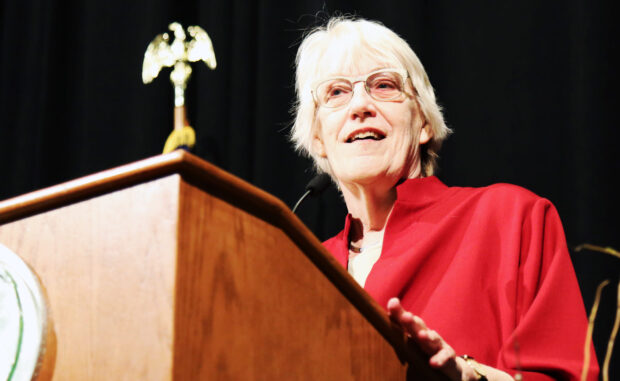The creator — and namesake — of Idaho’s most widely used teacher evaluations system is very skeptical about how the state is using her system to make high-stakes teacher pay decisions.

Consultant, author and longtime educator Charlotte Danielson said she is concerned that principals and administrators were put in charge of evaluations without enough training. As a result, Danielson believes evaluation scores are likely inflated in Idaho and other states.
“I want to make sure the right people are getting the raise, and I’m not convinced,” she said.
Danielson agreed to be interviewed by Idaho Education News this week, as a followup to a keynote speech in Boise last week.
Danielson developed and wrote “The Framework for Teaching,” first publishing it in 1996, after determining that there is no universal definition for good teaching.
The 2015 Legislature passed Idaho’s “career ladder” salary law, tying a teacher’s ability to earn raises to performance on evaluations. The vast majority of Idaho’s 115 school districts use Danielson’s framework as its evaluations model.
Teacher evaluations have become an increasing source of controversy since Gov. Butch Otter signed the career ladder law. In June 2015, Idaho EdNews began reporting on significant inaccuracies and irregularities among evaluations.
In 2016, Superintendent of Public Instruction Sherri Ybarra sat on a critical outside review of evaluations. Ybarra released the taxpayer-funded report to lawmakers and the public only after Idaho EdNews obtained it via a public records request, almost six months after Ybarra first received the report.
Then, in February, the State Board of Education released a separate review of evaluations that found 25 percent of evaluations screened did not include evidence of two separate classroom observations. Under Idaho law, administrators have been required for years to conduct a minimum of two classroom observations per teacher per year.
One of Danielson’s most pressing concerns with tying evaluations to pay raises is that administrators tend to overinflate scores. Her solution is expensive. However, Danielson would feel more comfortable if neutral, outside experts specifically certified in evaluations were brought in to conduct evaluations and classroom observations. Ohio uses such a system.
An Idaho Education News analysis of 2015-16 data found administrators of 35 school districts or charter schools awarded identical overall evaluation scores of “proficient” to every single teacher.
That is a major red flag, Danielson said.
“People are justified in being skeptical of how accurate evaluations are because in most states 98 percent of teachers are given the top two ratings, or some unlikely percentage — nobody really believes that’s the case,” Danielson said. “That keeps everybody quiet and nobody is going to complain about that, that’s probably one reason to do it.”
Across Idaho, less than 3 percent of all 15,571 teachers earned scores below the top two scores of “proficient” and “distinguished.”
“There are all these social pressures that are pushing the evaluator into being lenient,” Danielson said. “They maybe hired this person or don’t want to alienate their staff.”
Shortly after Ybarra took office, Idaho stopped tracking the number of administrators trained in evaluations through a program called Teachscape, State Department of Education spokesman Jeff Church said. Through March 2015, the state purchased licenses for 762 of Idaho’s 942 administrators to participate in the online training. In all, 456 earned a proficiency certificate after passing an assessment, while 277 administrators did not take the assessment.
To be clear, Danielson is not attacking teachers. During an April 6 speech in Boise, Danielson told a crowd of several hundred teachers that they have the most challenging and complex job in the world.
“Teachers make hundreds of decisions a day — no wonder they are exhausted at the end of the day,” Danielson said. “It’s demanding.”
But she finds flaws in using evaluations to award raises. For instance, Danielson said it would be perfectly normal for teachers in their first couple years on the job to earn overall scores of “basic” on evaluations.
Yet, in 83 Idaho school districts or charters, administrators reported exactly zero scores of basic. Across the state, only 2.7 percent of all teachers earned scores of basic.
“Basic and proficient are just degrees of good,” Danielson said. “Basic is typical and characteristic of people just beginning their practice who are literally doing everything for the first time.”
Danielson also urged people to be wary of excess “distinguished” scores — the top score on the four-point scale.
“Distinguished is a nice place to visit occasionally, but don’t expect to live there,” Danielson said. “It’s too hard to sustain.”
State officials, most notably Otter, are also concerned with the accuracy and validity of teacher evaluations. During his post-legislative press conference last week, Otter said teachers evaluation data is the accountability piece needed to justify the state’s planned $250 million investment in increasing teacher pay.
“All of those commitments were made on the basis of accountability, and it’s the accountability piece we still find ourselves falling short with,” Otter said.
Earlier this year, the Legislature approved $1 million in new funding to provide evaluations training to local school administrators.
Further reading: Writing for Education Week a year ago, Danielson explains her concerns over evaluations.
